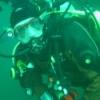SDM - Assuming your RB (any model) does go fubar, what redundancies are there? Can your buddy share his RB like a recreational octo or are you limited to your own backup tanks? What do they give you for gas? Does the rule of thirds apply? How?
I see guys diving rebreathers in pairs and those questions have always been on my mind. If in a long DECO or cave situation, how is this handled?
Thx...
The second part is easier..... I'll let SDM tackle failure modes and options.... you have to be prepared to bailout at any time, rb's only have one DSV, so no buddybreathing. Gas planning in RB teams is a debated topic in the community right now. Suffice it to say, the team needs somewhere between 1.5-2x in reserve bailout to get the team back from..... (the difference comes down to planning for multiple catestrophic failures or a single, if multiple - how far down the rathole do you go....)
... furthest point of penetration
... ascent
... and any deco obligation
Now, what form is bailout.... lets talk about gas... we have onboard and offboard. Onboard gas is the two bottles; diluent and oxygen connected up to the unit. Offboard would be additional carried or staged bottles. Depending on the dive, bailout might be entirely onboard (such as using 27cu or larger tanks on a recreational NDL dive), or entirely offboard which is the more common implementation I've seen (and use). In this case, offboard bailout is generally 1 or 2 AL40's or AL80's w/ a 2nd stage and an decent sized inflator hose. Depending on the situation, we might jack the gas into the unit to supliment onboard supplies, or we might totally bailout and go to the 2nd stage directly.
Like any form of technical diving; at first indication of any failure, the dive is called.
Also, sizing bailout comes with the addage; don't skimp...
In the caves, its nothing to take a few more bottles in and drop them along the line, or to dump a bottle or two of O2 in the basin.... in 99.9999% circumstances, your guarenteed to be egressing down the same path. In wrecks; seas, ladders, and other conditions can become hurdles, so it becomes a factor in dive planning... i.e. for our dive tomorrow, do I really want to do 40 minutes at 200'... how much bailout will I need to drag along (2 x 80's, 1x18/45 & 1x50)... or should I limit to 25 minutes (2 x 40's, same mixes)
Now, the planning I covered above, really should be no different than the reserve planning ANY open water diver does for every dive; open, closed, recreational, technical..... Give a read for the concept of 'Rock Bottom' when it comes to gas planning.
Now, to make this even more complicated, there are some people doing exploration that have determined conventional open circuit bailout to be a limiting factor in the dives, and have opted for a BOB.... BailOut reBreather... A 2nd, totally isolated kit that would sustain bailout facilities should the primary rebreather fail. You can see examples of the Hammerhead and Megalodon in these configurations, as well as smalled AL80's sized units meant to be slung like a stage - this is most certainly not the general 'recreational/technical diving public' here. But it's worth mentioning as there is alot of thought working in that direction.
-Tim


















